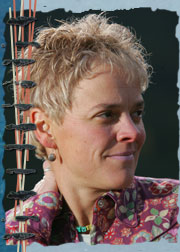<< Return to Articles and Reviews
See Magazine: Down on Buffalo Street: History percolates on Brewster's newest album
By Bryan Birtles
Having lived in a lot of places in Western Canada—including an extended stint in Edmonton where she hosted CJSR Radio's "Sonic Sisters" show, which focused on female singer-songwriters—Cori Brewster moved back to the Banff area in 2000 to reconnect with her roots. As a member of the Brewster family of Banff—that would be the one who arguably launched tourism in the area—her connections to the place are palpable, and her experiences growing up in Banff were something she wanted to share with her young son.
"I have a 10-year-old son and I primarily moved back for him in the sense that I wanted to bring him back to the mountains because I grew up here," she says. "I was born in Banff, my family certainly has a long history in Banff, my father was born here, my grandfather was born here, my great grandfather arrived here in 1886, so my roots run very, very deep. I'm certainly aware of the Brewster history in this area and I wanted to investigate it."
That investigation has ultimately led to Brewster's newest album. Entitled Buffalo Street after the street on which Brewster grew up, the album is a rootsy take on some of the historical characters and places in Banff—with a special focus on some of the lesser-known characters in the town's history. While there's a tune about Wild Bill Peyto, the moustachioed gentleman recognizable from the sign that welcomes visitors to the park, there is also a song about William Twin, a Stoney/Nakoda man who befriended the Brewster family in the 1800s and helped them launch their tour-guide empire, as well as Louis Trono, a well-known trombonist and character around Banff.
"I didn't really have a list of people I wanted to write about," Brewster says of the choices she made on the disc. "I had been aware, having grown up in Banff, of some of these people but I didn't approach it with the idea of, 'I'm gonna write about this person or that person.' I certainly tried to avoid people whose names were more out there and so I was drawn to people that I wanted to uncover so to speak."
In order to uncover the stories she wanted to write about, Brewster spent a significant amount of time doing research in Banff's Whyte Museum. The final decision about whether someone's story was one she was drawn to write about came down to the same thing every time, she says.
"There certainly has to be an 'ah ha!' moment where you go, 'Oh, that's really neat,' or a secret story that comes out," she says. "The Whyte Museum staff were great at pointing me in a lot of different directions and to keep digging because that's the trick. You'll find a couple of articles and you'll read them but you certainly can't base a story on that—you need to keep digging and find that hidden gem that you can really relate to that really will take you to the place that you can actually invest in the story."

